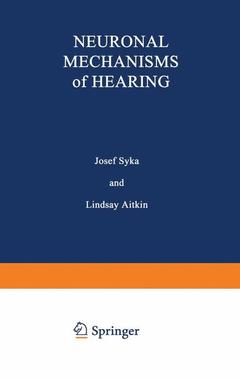Description
Neuronal Mechanisms of Hearing, Softcover reprint of the original 1st ed. 1981
Coordinator: Aitkin Lindsay
Language: English
Subject for Neuronal Mechanisms of Hearing:
Keywords
attention; biochemistry; brain; communication; cortex; experiment; forebrain; information processing; nervous system; neurons; perception; physiology; system; time
Publication date: 03-2012
444 p. · 17.8x25.4 cm · Paperback
444 p. · 17.8x25.4 cm · Paperback
Description
/li>Contents
/li>
In contrast to the level of interest which is paid to the orga nization of meetings about the structure and function of the audi tory periphery, the central auditory system has received little attention in the last several years. However, much recent data accu mulated during this period has provided auditory physiologists with new ideas about the function of the central auditory system. The successful exploration of new anatomical tracing techniques (triti ated aminoacids, horseradish peroxidase, 2-deoxyglucose) together with the collection of electrophysiological data obtained with intra cellular and extracellular recordings from the receptors and neurones in the auditory pathway have considerably deepened our understanding of central auditory function. Particular interest was concentrated upon the development of the auditory system under normal conditions and in conditions ofaudi tory deprivation. Although, from the methodological point of view, the conditions of reversible auditory deprivation are complicated, promising new data appeared in this field. Similarly the specific ability of the auditory system to encode communication signals and speech sounds has been examined in many laboratories allover the world. A very fruitful method. based upon the results of electrical stimulation of cochlear nerve fibres in experimental animals, is the application of neuroprostheses in deaf patients. At the present time, the method still does not meet all requirements and many improvements will be necessary. Undoubtedly the exploration of the results of recent physiological experiments may help in the further improvement of neuroprostheses.
Session I. Cochlear mechanisms A.- The Responses of Hair Cells to Low Frequency Tones and Their Relationship to the Extracellular Receptor Potentials and Sound Pressure Level in the Guinea Pig Cochlea.- Some Comparative Aspects of a Cochlear Mechanism.- The Parasympathetic Innervation of the Inner Ear and the Problem of Cochlear Efferents: Enzyme and Autoradiographic Studies.- Adaptation and Dynamic Response Occurring at Hair Cell — Afferent Fiber Synapse.- Phase Versus Frequency Plots from Caiman Primary Auditory Fibres: Is There a Travelling Wave?.- Session II. Cochlear Mechanisms B.- The Dynamics of pO2-Changes in the Perilymphatic Perfusate of the Guinea Pig Cochlea Depending on the Metabolism.- Analytical Studies on Biochemistry and Physiology of Perilymph (Guinea Pig).- Distribution of Microphonic Potentials in the Four Turns of the Guinea Pig Cochlea.- Session III. Coding in the Auditory Nerve and Cochlear Nucleus.- The Dynamic Range Problem: Place and Time Coding at the Level of Cochlear Nerve and Nucleus.- Coding of Complex Sounds in the Auditory Nervous System.- On Predicting the Response of Auditory Nerve Fibers to Complex Tones.- Effects of Masking Noise on the Representation of Vowel Spectra in the Auditory Nerve.- Neuronal Circuits in the Dorsal Cochlear Nucleus.- The Internal Organization of the Dorsal Cochlear Nucleus.- Session IV. Central Auditory Mechanisms A.- Functional Organization of the Inferior Colliculus.- Integration and Segregation of Input to the Cat Inferior Colliculus.- Some Facets of the Organization of the Principal Division of the Cat Medial Geniculate Body.- Functional Organization of the Medial Geniculate Body Studied by Simultaneous Recordings of Single Unit Pairs.- Possibilities of Recording Multiunit Activity in the Auditory Pathway.- Poststimulatory Effects in the Medial Geniculate Body of Guinea Pigs.- How Biosonar Information Is Represented in the Bat Cerebral Cortex.- Three-Dimensional Study of Evoked Field Potentials in the Auditory Cortex of the Cat.- Differential Diagnosis of Hearing Disorders-Clinical Findings Contributing to Information Processing in the Auditory Pathway.- Session V. Central Auditory Mechanisms B.- Binaural Interaction in the Cat Inferior Colliculus: Comparison of the Physiological Data with a Computer Simulated Model.- Coding Properties of the Different Nuclei of the Cat’s Medial Geniculate Body.- Interaural Delay Sensitive Units in the MGB of the Cat.- Temporal Information in the Medial Geniculate Body.- Some Investigation of Acoustical Evoked Potentials from Peripheral and Central Structures of the Auditory Pathway in Rabbits.- Session VI. Auditory Localization.- Anatomical-Behavioral Analyses of Hindbrain Sound Localization Mechanisms.- Effects of Unilateral Ablation of Anteroventral Cochlear Nucleus on Localization of Sound in Space.- Binaural Interaction Models and Mechanisms.- Psychophysical and Neurophysiological Data on the Sound Source Perception.- Session VII. Neural Coding of Speech and Complex Stimuli.- Information Processing in Neuronal Populations of the Human Brain during Learning of Verbal Signals.- A Comparison of the Responses Evoked by Artificial Stimuli and Vocalizations in the Inferior Colliculus of Squirrel Monkeys.- Acoustic Properties of Central Auditory Pathway Neurons during Phonation in the Squirrel Monkey.- Selectivity of Auditory Neurons for Vowels and Consonants in the Forebrain of the Mynah Bird.- Some Aspects of Functional Organization of the Auditory Neostriatum (Field L) in the Guinea Fowl.- 14-C-Deoxyglucose Labeling of the Auditory Neostriatum in Young and Adult Guinea Fowl.- Integration of Voco-Auditory Centers in Song Birds.- Response Properties and Spike Waveforms of Single Units in the Torus Semicircularis of the Grassfrog (Rana Temporaria) as Related to Recording Site.- Coding of Amplitude-Modulated Sounds in the Midbrain Auditory Region of the Frog.- Session VIII. Deprivation and Developmental Studies.- Effects of Early Auditory Stimulation on Cortical Centers.- Effects of Acoustic Deprivation on Morphological Parameters of Development of Auditory Neurons in Rat.- Behavioral and Anatomical Studies of Central Auditory Development.- Input-Dependent 2-Deoxy-D-Glucose Uptake in the Central Auditory System of Rana Temporaria.- Plastic Changes in the Inferior Colliculus Following Cochlear Destruction.- Developmental Changes of Auditory Evoked Responses in Normal and Kanamycin Treated Rats.- Session IX. Auditory Prostheses, Physiological Background.- Physiological Background of Hearing Prostheses.- Electrical Stimulation of the Human Cochlea — Psychophysical and Speech Studies.- Preliminary Speech Perception Results through a Cochlear Prosthesis.- Tactile Aid for the Deaf; Search of a Code Allowing Somesthetic Processing of Acoustic Messages.- Participants.
© 2024 LAVOISIER S.A.S.
These books may interest you

The Human Auditory Cortex 158.24 €

The Human Auditory Cortex 158.24 €

The Auditory Cortex 210.99 €

